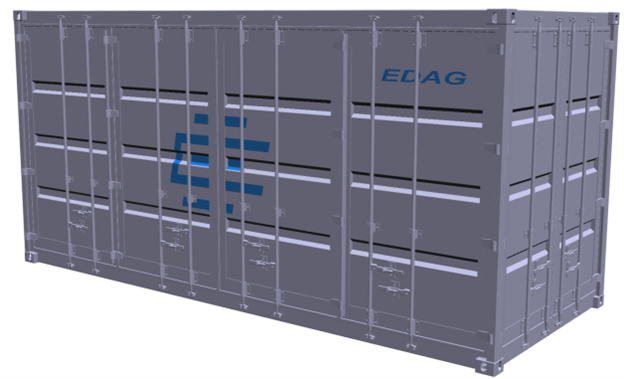With the growing share of renewables in the energy mix, the demand for battery energy storage systems (BESS) has risen rapidly. At the same time, raw material prices have plummeted. These developments present lucrative business models and opportunities for optimizing and monetizing energy flows for energy providers, grid operators, industrial companies, and project developers. Industrial consumers, in particular, can benefit from these opportunities by smoothing load peaks and thus reducing costs through more efficient energy use. Battery energy storage systems are evolving from a niche product to a key technology for the future of energy supply. Flexibility, scalability, and the continuous optimization of production technologies play a crucial role in this transformation.
Growing demand for BESS
The fluctuating availability of renewable energy presents significant challenges for the power grid. Wind and solar energy are weather-dependent and subject to daily fluctuations, resulting in irregular energy production. Storage solutions are essential to ensure a continuous energy flow, grid stability, and the 24/7 availability of power from renewable sources. Numerous studies predict dynamic growth in storage capacity over the coming years. According to a study by Frontier Economics, the capacity of large-scale battery storage in Germany could increase more than tenfold by 2030, reaching a total capacity of 15 gigawatts. The Federal Network Agencyʼs Grid Development Plan (NEP) anticipates an installed BESS capacity of 36 gigawatts by 2045. This surge is accompanied by a veritable boom in connection requests. Even if not all proposed projects will be realized, current forecasts will likely be exceeded. These figures highlight the urgency of expanding battery energy storage capacity.
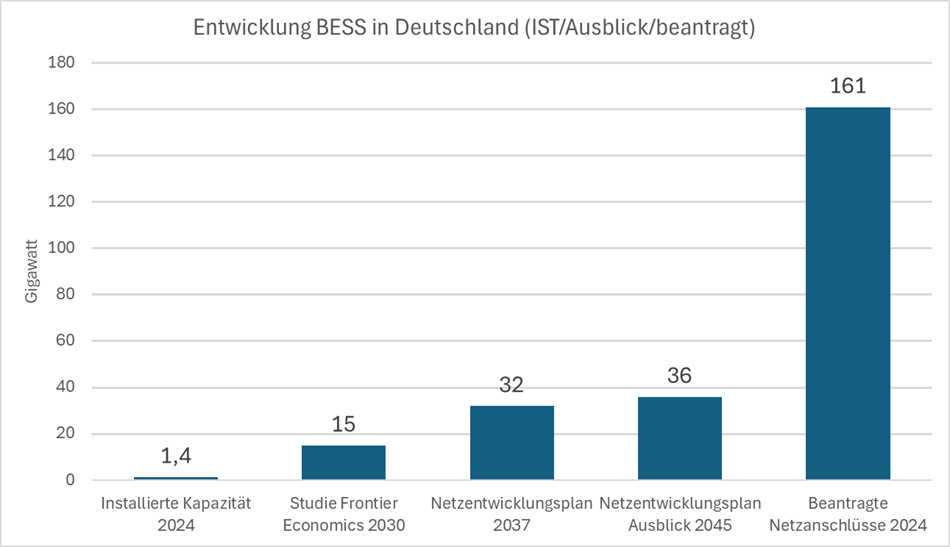
BESS market development (source: EDAG PS, based on Montel, battery-charts, Grid Development Plan 2025/2037, Frontier Economics)
Falling prices transforming the market
Battery production costs have fallen significantly within a single year. This trend can be attributed to several factors. Firstly, declining raw material prices, particularly for key resources, have dropped by 40 percent. For example, the price of lithium has plummeted from over 75,000 US dollars to 12,325 US dollars per ton within twelve months, enabling the development of cost-efficient cell chemistries. Secondly, iIncreased production capacity has led to an oversupply of batteries, particularly in China. With growing supply and, in some markets, stagnant or even declining demand, prices have fallen. Thirdly, iImproved manufacturing processes and advancements in battery technology have further contributed to cost reductions. Access to more affordable battery cells provides market participants with economically viable storage options.
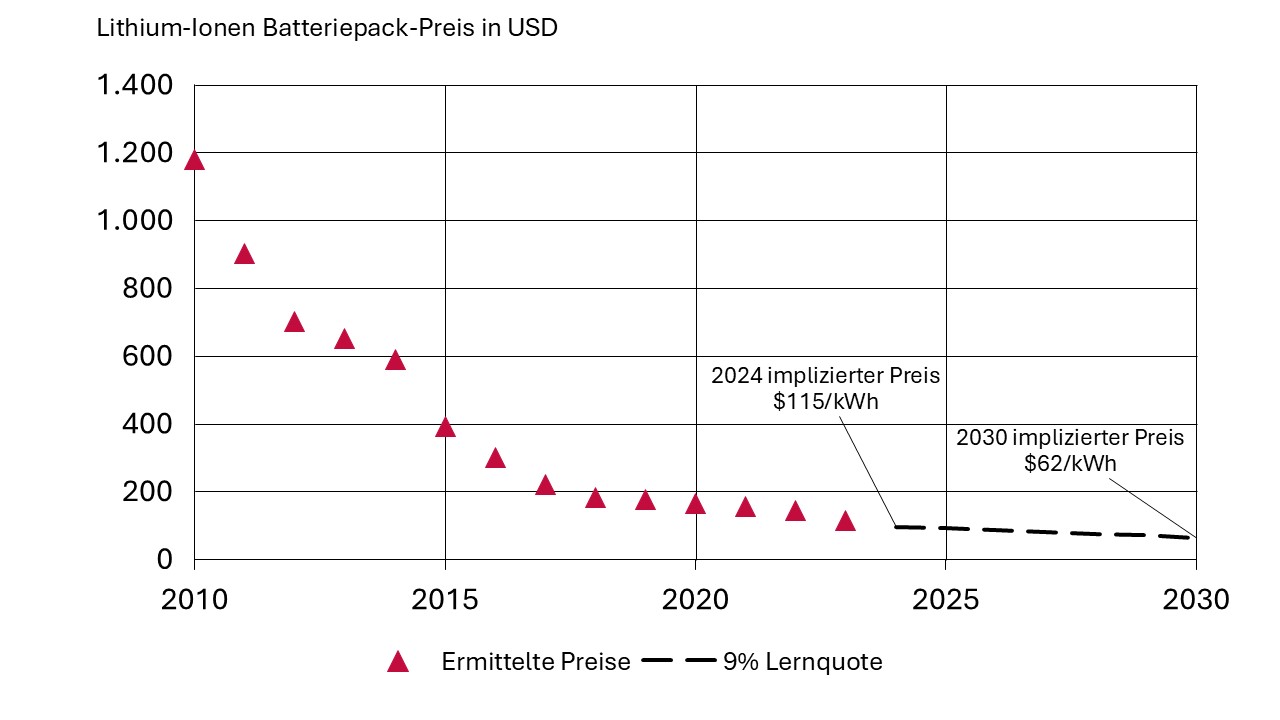
Price development of lithium-ion batteries to 2030 (source: EDAG PS, based on BloombergNEF)
Demand for BESS production capacity
The rapid growth of the BESS market demands a scaling of production capacities and optimization of manufacturing processes. EDAG Production Solutions (EDAG PS) addresses this challenge with innovative solutions. In 2023, as part of a development project, a concept study for a versatile battery energy storage system was created which offers cross-sector solutions for competitive BESS and their efficient production. The concept study is technology-neutral and compatible with various cell chemistries, such as nickel-manganese-cobalt (NMC), lithium iron phosphate (LFP), and sodium-ion batteries (SIB). It also supports different cell formats, including pouch cells, cylindrical cells, and prismatic cells. The BESS concept study is characterized by a cost-efficient system architecture, high charge and discharge rates, and excellent cycle stability. It enables safe operation even under challenging environmental conditions and meets all common industrial standards, making it flexible for different market requirements.
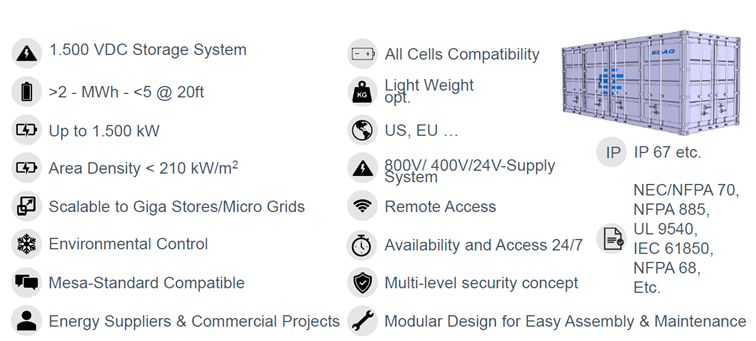
Possible configurations of the stationary EDAG storage system (source: EDAG)
Blueprint for efficient BESS production
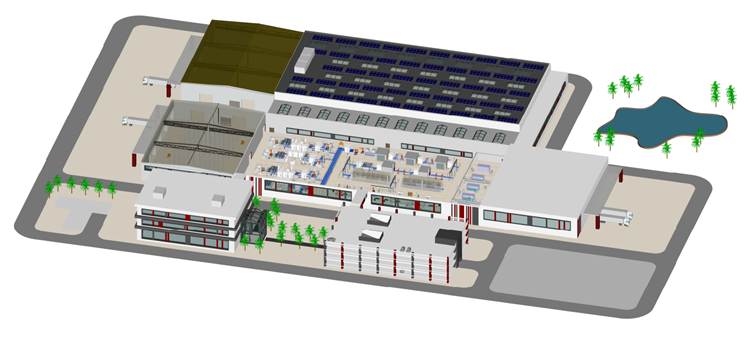
Blueprint of flexible, scalable BESS production (source: EDAG PS)
Based on the BESS concept study, EDAG PS has developed a blueprint for the production of battery energy storage systems that support an annual production capacity of 500 to 3,000 megawatt-hours, equivalent to approximately 900 BESS units per year. The safe handling of battery components in high-volume production requires precise manufacturing processes. Reproducible production steps and continuous process monitoring ensure high process stability. The use of simulation applications allows production facilities to be optimized for efficiency and flexibility, ensuring readiness before commissioning.
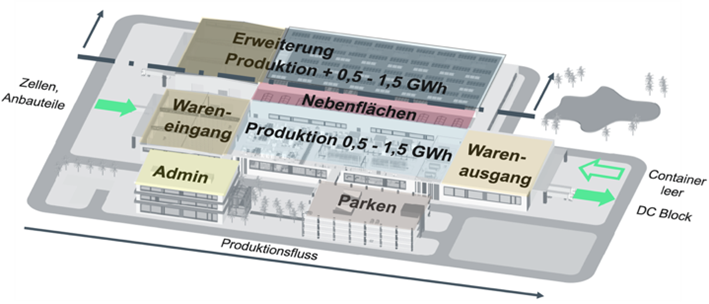
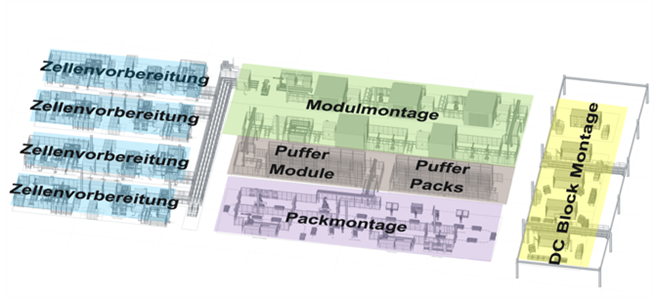
Blueprint of flexible, scalable BESS production for 0.5 to three megawatt-hours (source: EDAG PS)
Success factors for scaling
A key success factor for scaling BESS lies in automation strategies. Higher degrees of automation reduce production ramp-up times, significantly lower operating costs, and enhance product quality. A flexible production infrastructure allows manufacturers to quickly adapt to demand fluctuations and adjust production capacity as needed. In a market as dynamic as that of BESS, this offers decisive advantages:
- Planning reliability: Early clarity on critical factory metrics, such as financial requirements, operating costs, space requirements, and system efficiency.
- Reduced project risks: Manageable technologies and robust processes, such as automation solutions in cell stacking, mitigate project risks.
- High value creation: The production process, from battery cell to finished battery energy storage system, enables high value creation.
- Optimized manufacturing: Efficient flow production with appropriate automation levels and manageable product variants optimizes production.
EDAG as a partner for BESS production
EDAG Production Solutions represents 360-degree production engineering within the EDAG Group. As a partner for planning, designing, optimizing, and implementing production facilities, EDAG PS integrates product development seamlessly into these processes. With approximately 1,300 employees and over five decades of experience, EDAG PS is a cross-industry innovator in developing production facilities. In battery production, EDAG PS leverages experience from more than 200 projects, focusing on storage solutions for industrial applications in the energy sector. From cell preparation to module and final assembly and operational testing, EDAG PS develops and implements production facilities and factories for BESS, always having scalability in mind, from laboratory scale to series production.
Author: Kai Mattusch, EDAG Production Solutions
Sources:
[1] ISEA RWTH Aachen: Battery Charts, [online], https://battery-charts.rwth-aachen.de, accessed December 1st, 2024;
Montel News: “ÜNB verzeichnen 161 GW an Batterieanschlussfragen,” [online], https://montelnews.com/de, accessed December 1st, 2024;
Frontier Economics (2023): Value of Large Battery Storage in the German Power System, [online], https://www.frontier-economics.com/de, accessed December 1st, 2024;
NEP: Grid Development Plan 2037/2045 (2034), [online], https://www.netzentwicklungsplan.de, accessed November 20th, 2024
[2] Handelsblatt: “Energy: Falling Lithium Prices Are Changing the Battery Market,” (July 24th, 2024), https://www.handelsblatt.com, accessed November 20th, 2024

